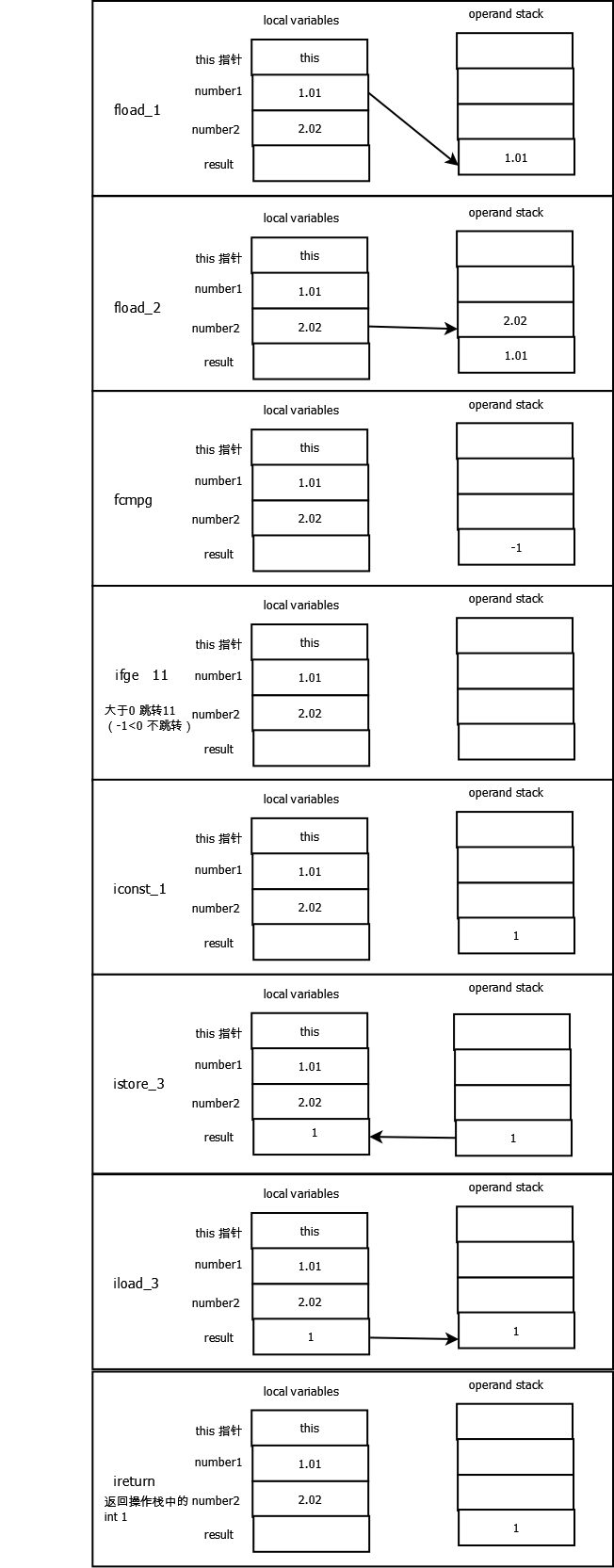JVM 线程栈 到 函数运行
每一个JVM线程来说启动的时候都会创建一个私有的线程栈。一个jvm线程栈用来存储栈帧,jvm线程栈和C语言中的栈很类似,它负责管理局部变量、部分运算结果,同时也参与到函数调用和函数返回的工作中。JVM规范中运行线程栈的大小可以是固定的或者是动态分配的,也可以是根据一定规则计算的。不同jvm对栈的实现会不同,一些可能提供给开发人员自己控制jvm线程栈初始大小的方式;对于动态分配来说也可能提供对jvm最大和最小值的设置。
当计算一个线程需要的分配的大小超出了固定值、或者设置的最大值,jvm会抛出StackOverflowError。而对于动态分配栈来说,如果内存不能够提供足够的空间来满足最小值、或者需要的值JVM会抛出 OutOfMemoryError
栈帧,可以理解成一个函数执行的环境,它管理参数、局部变量、返回值等等。
每个栈帧都包括一个管理局部变量的数组( local variables),这个数组的单元数量在编译成字节码的时候就能确定了。对于32-bit 一个单位能够存放 boolean, byte, char, short, int, float, reference,returnAddress;连续两个单位就能够用来存储long 、double。局部变量数组的下标是从0开始,一般而言0位置存储的是this,后面接着是函数的参数,再是函数中出现的局部变量。
每个栈帧也都包括一个(LIFO)操作栈的数据结构(operand stack),它的大小同样也可以在编译的时候确定,创建的时候会是个空栈。举个简单的例子,来描述它公用,对于int a+b来说,先把push a 进入栈中,再朴实 b 进入入栈中,然后 同时pop 两个值执行iadd 指令,再将其加后的结果push入栈中完成指令。
除开以上两个关键的结构,每个栈帧还有常量池( run-time constant pool)、异常抛出管理等结构。在此就不一一详细说来了,可以参考其他资料。
再来通过一个简单的 Demo 来说明,一个栈帧的工作。首先,我们来看这样的一个函数:
public int comp(float number1, float number2){
int result ;
if(number1 < number2)
result = 1;
else
result = 2;
return result;
}
其中函数内逻辑对应的字节码,如下:
0: fload_1
1: fload_2
2: fcmpg
3: ifge 11
6: iconst_1
7: istore_3
8: goto 13
11: iconst_2
12: istore_3
13: iload_3
14: ireturn
对于这几个字节码指令稍微说明下:
fload_x:取局部变量数组中第x个,类型fload,push 入栈;
fcmpg:比较两个单精度浮点数。如果两数大于结果为1,相等则结果为0,小于的话结果为-1;
ifge:跳转指令;
iconst_x:push 常量x入栈;
istore_x:pop栈存入局部变量数组第x个;
iload_x:读取局部变量数组第x个,入栈;
ireturn:函数结束返回int型;
细心点观察可以发现i开头指代int,f开头指代fload,load代表载入,if代表跳转等等,其中字节码的操作码定义也是有一定意义的,详情可以翻译jvm字节码相关标准。再来看看,jvm如何在栈帧结构上执行情况,以具体调用comp(1.02,2.02)为例:

Java 的 Class
说字节码,一定少不了.class。不妨,以一个demo类 来具体看class 的内容,类非常简单,两个函数一个say,另外一个就是上面的cmp函数。
public class Hello {
public void say(){
System.out.println("Hello world!");
}
public int comp(float number1, float number2){
int result ;
if(number1 < number2)
result = 1;
else
result = 2;
return result;
}
}
用 javac -g:none Hello.java 来编译这个类的,然后用 javap -c -v Hello.class 来解析编译的class。
Classfile /src/main/java/com/demo/Hello.class
Last modified 2016-10-28; size 404 bytes
MD5 checksum 9ac6c800c312d65b568dd2a0718bd2c5
public class com.demo.Hello
minor version: 0
major version: 52
flags: ACC_PUBLIC, ACC_SUPER
Constant pool:
#1 = Methodref #6.#14 // java/lang/Object."":()V
#2 = Fieldref #15.#16 // java/lang/System.out:Ljava/io/PrintStream;
#3 = String #17 // Hello world!
#4 = Methodref #18.#19 // java/io/PrintStream.println:(Ljava/lang/String;)V
#5 = Class #20 // com/demo/Hello
#6 = Class #21 // java/lang/Object
#7 = Utf8
#8 = Utf8 ()V
#9 = Utf8 Code
#10 = Utf8 say
#11 = Utf8 comp
#12 = Utf8 (FF)I
#13 = Utf8 StackMapTable
#14 = NameAndType #7:#8 // "":()V
#15 = Class #22 // java/lang/System
#16 = NameAndType #23:#24 // out:Ljava/io/PrintStream;
#17 = Utf8 Hello world!
#18 = Class #25 // java/io/PrintStream
#19 = NameAndType #26:#27 // println:(Ljava/lang/String;)V
#20 = Utf8 com/demo/Hello
#21 = Utf8 java/lang/Object
#22 = Utf8 java/lang/System
#23 = Utf8 out
#24 = Utf8 Ljava/io/PrintStream;
#25 = Utf8 java/io/PrintStream
#26 = Utf8 println
#27 = Utf8 (Ljava/lang/String;)V
{
public com.demo.Hello();
descriptor: ()V
flags: ACC_PUBLIC
Code:
stack=1, locals=1, args_size=1
0: aload_0
1: invokespecial #1 // Method java/lang/Object."":()V
4: return
public void say();
descriptor: ()V
flags: ACC_PUBLIC
Code:
stack=2, locals=1, args_size=1
0: getstatic #2 // Field java/lang/System.out:Ljava/io/PrintStream;
3: ldc #3 // String Hello world!
5: invokevirtual #4 // Method java/io/PrintStream.println:(Ljava/lang/String;)V
8: return
public int comp(float, float);
descriptor: (FF)I
flags: ACC_PUBLIC
Code:
stack=2, locals=4, args_size=3
0: fload_1
1: fload_2
2: fcmpg
3: ifge 11
6: iconst_1
7: istore_3
8: goto 13
11: iconst_2
12: istore_3
13: iload_3
14: ireturn
StackMapTable: number_of_entries = 2
frame_type = 11 /* same */
frame_type = 252 /* append */
offset_delta = 1
locals = [ int ]
}
解释下其中涉及的新的操作码
getstatic:获取镜头变量;
invokevirtual:调用函数;
return:void 函数结束返回;
在 public int comp(float, float) code 这段代码里面就能看到上面提到的字节码运行的例子。有了个感性认识,其实大体看到class文件里面,除了字节码指令外,还包括了常量pool,访问标志(public 等),类的相关信息(属性、函数、常量等)。因为前面用的是 -g:node进行编译的,其他模式下还可以有其他扩展、调试信息也包括在class里面。官方给出的class文件格式,详细如下:
ClassFile {
u4 magic;
u2 minor_version;
u2 major_version;
u2 constant_pool_count;
cp_info constant_pool[constant_pool_count-1];
u2 access_flags;
u2 this_class;
u2 super_class;
u2 interfaces_count;
u2 interfaces[interfaces_count];
u2 fields_count;
field_info fields[fields_count];
u2 methods_count;
method_info methods[methods_count];
u2 attributes_count;
attribute_info attributes[attributes_count];
}
magic: 就是非常有名的 0xCAFEBABE ,一个标识class文件;
minor_version 、major_version :指的是java class 文件的版本,一般说class文件的版本是 XX.xx 其中XX 就是major,xx是minor,比如上面demo中的版本是52.0 代表就是 minor 0,major 51.
constant_pool_count:就是常量池元素个数,cp_info constant_pool[constant_pool_count-1] 就是相关的详细信息了。
access_flags:指的是访问标识例如ACC_PUBLIC、ACC_FINAL、ACC_INTERFACE、ACC_SUPER 写过java的相信看名字应该知道啥意思,ACC是access的缩写。
其他具体的,就不一一介绍了详细可以直接参考官方文档。
动态生成java字节码
当然,你可以直接按照官方的class文件格式来直接写 byte[],然后自定义个 class load 载入编写的byte[]来实现动态生成class。不过,这个要求可能也有点高,必须的非常熟悉class文件格式才能做到。这里demo还是借助 ASM 这个类库来简单演示下,就编写下 上面的Hello 不过里面只实现say的方法。如下:
public class AsmDemo {
public static final String CLASS_NAME = "Hello";
public static final AsmDemoLoad load = new AsmDemoLoad();
private static class AsmDemoLoad extends ClassLoader {
public AsmDemoLoad() {
super(AsmDemo.class.getClassLoader());
}
public Class defineClassForName(String name, byte[] data) {
return this.defineClass(name, data, 0, data.length);
}
}
public static byte[] generateSayHello() throws IOException {
ClassWriter classWriter = new ClassWriter(ClassWriter.COMPUTE_MAXS);
classWriter.visit(V1_7, ACC_PUBLIC + ACC_SUPER, CLASS_NAME, null, getInternalName(Object.class), null);
//默认初始化函数
Method constructorMethod = Method.getMethod("void ()");
GeneratorAdapter constructor = new GeneratorAdapter(ACC_PUBLIC, constructorMethod, null, null, classWriter);
constructor.loadThis();
//每个类都要基础Object
constructor.invokeConstructor(Type.getType(Object.class), constructorMethod);
constructor.returnValue();
constructor.endMethod();
Method mainMethod = Method.getMethod("void say ()");
GeneratorAdapter main = new GeneratorAdapter(ACC_PUBLIC, mainMethod, null, null, classWriter);
main.getStatic(Type.getType(System.class), "out", Type.getType(PrintStream.class));
main.push("Hello world!");
main.invokeVirtual(Type.getType(PrintStream.class), Method.getMethod("void println (String)"));
main.returnValue();
main.endMethod();
return classWriter.toByteArray();
}
public static void main(String[] args) throws IllegalAccessException, IllegalArgumentException,
InvocationTargetException, InstantiationException, NoSuchMethodException, SecurityException, IOException {
byte[] code = AsmDemo.generateSayHello();
//反射构建 hello 类,调用hello方法。
Class hello = load.defineClassForName(CLASS_NAME, code);
hello.getMethod("say", null).invoke(hello.newInstance(), null);
}
}
关于动态生成字节码用途,一定场景下是可以提升效率与性能,因为动态生成的类和普通的载入类并无太大区别。手工优化后的字节码执行可能比编译的要优,可以替代反射使用的许多场景 同时避免反射的性能消耗。很著名的一个例子,fastJSON 就是使用内嵌 ASM 框架动态生成字节码类,来进行序列和反序列化工作,是目前公认最快的json字符串解析。